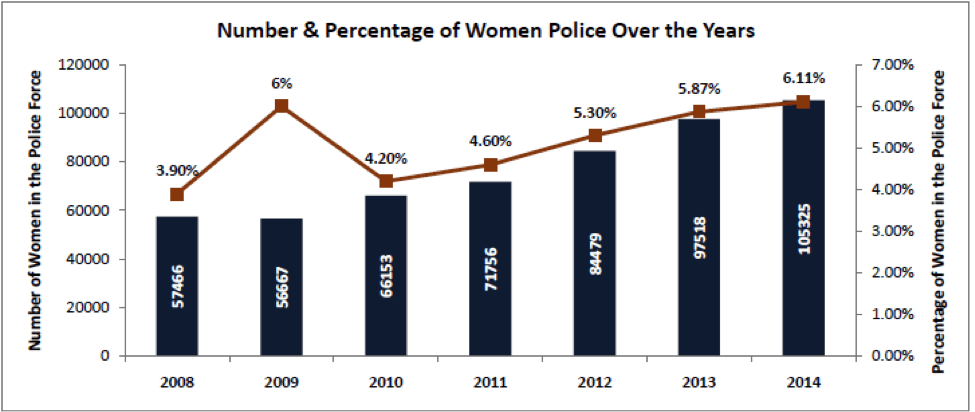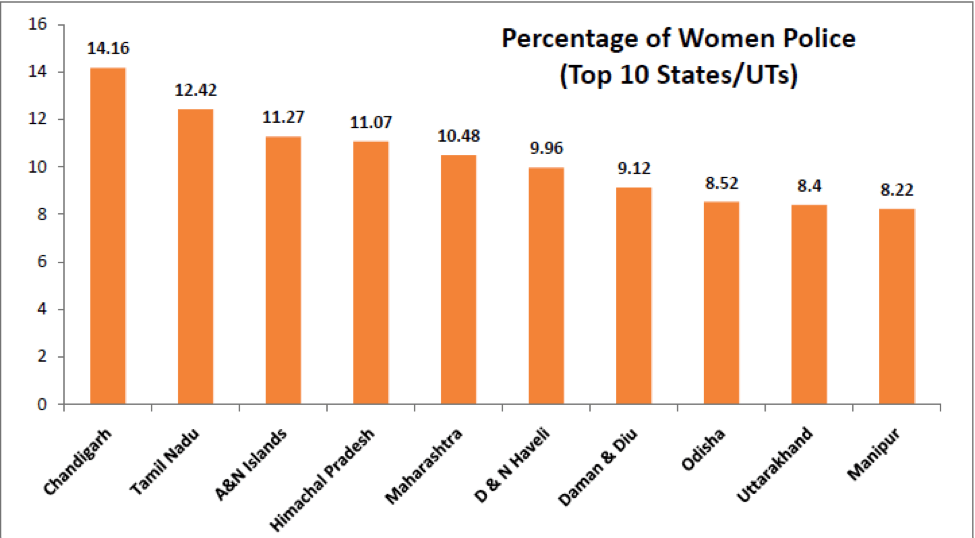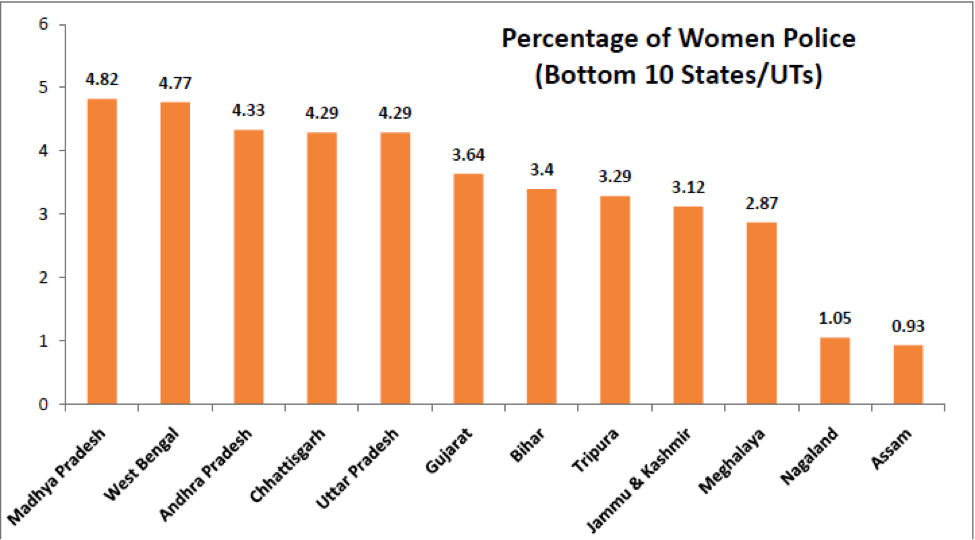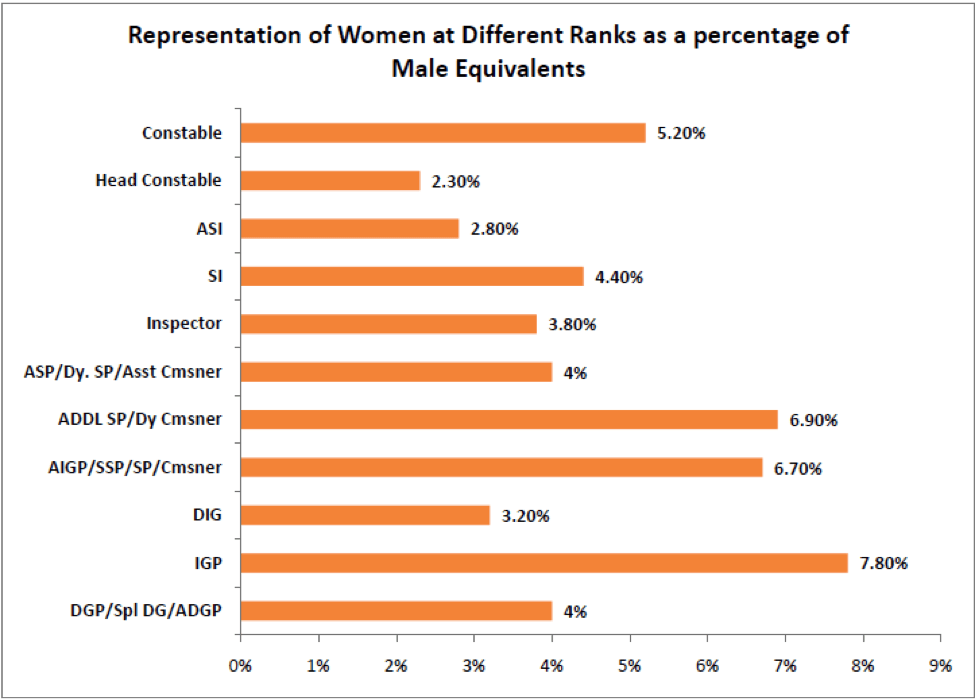[orc]Representation of Women in various fields has been a widely discussed issue off late. It goes without saying that Women are grossly underrepresented in several fields in India: whether in politics, senior corporate leadership or even the bureaucracy. A new report by the Commonwealth Human Rights Initiative (CHRI) paints an equally dismal picture of the Women in the Police Force. Women make up only 6.11% of the total police force in the country.
Women are grossly underrepresented in several fields in India: whether in politics, senior corporate leadership or even the bureaucracy. A new report launched by the Commonwealth Human Rights Initiative (CHRI) shines a light on the abysmally low numbers of women in the police force in India. The report while talking of the gender inequality in the police force in India also shines the spotlight on the structural causes, policy lacunae and attitudinal issues within the society in general and the police force in particular that are responsible for the skewed gender ratios in the police ranks.
Women in Police: The numbers
In India, the first woman police officer was appointed in Kerala, in the Travancore Royal police in 1933. The first woman IPS officer was appointed in 1972.
Of the 1,722,786 Police Officers in country today, only 105,325 are women across all ranks. This amounts, on an average to a mere 6.11% of the total police force in India, as of 1st January 2014( as per the date with Bureau of Police Research and Development, Ministry of Home Affairs). The numbers and proportion of women police officers vary significantly between the states, with Chandigarh having the highest (14.6%), followed by Tamil Nadu (12.4%) and Andaman & Nicobar (11.2%). Lowest among the states are Meghalaya (2.8%), Nagaland (1%) and Assam (0.9%).
The numbers have grown, albeit marginally, in the last 5 years, yet they are woefully short of the 33% threshold recommended repeatedly by the Ministry of Home Affairs. In 2008, women made up 3.9% of the total police officers, which has grown to 6.11% in 2014.
Within the South Asia region (the report covers Bangladesh, India, Pakistan and Maldives), Maldives ranks higher than India, with women comprising 7.4% of the police force. Bangladesh (4.6%) and Pakistan (0.9%) fare poorer within the countries researched in the report.
A UN Women report of 2011 estimates that, “globally, women average just 9 percent of the police, with rates falling as low as 2 percent in some parts of the world. On average, women do not make up more than 13 percent of the police force in any region”. In most developed countries, women make up up to 25% of the total force, with Scandinavian countries having around 30%.
Trends from the States: Some gains made
Numbers from the states points towards some gains made by them. Here are some of them as observed by CHRI.
- Meghalaya has almost doubled its numbers of female police officers from 174 in 2008 to 329 in 2014, which is overall an increase of 1%.
- Haryana has doubled its numbers from 1358 in 2008 to 2734 in 2014. This amounts to a three times increase in percentage terms from 2.7% to 6.5% in 2014. In 2011-12, Haryana added an additional 1000 additional officers
- Jharkhand has seen an increase from 1701 to 2906, particularly between 2013-14, when it added an additional 1000 officers which increased the percentage from 3.4% to 5.15%.
- Kerala has been pretty consistent over those years with no significant increase or decrease. Currently there are 3067 women, constituting 6.42% of the force.
- Rajasthan has seen a three times increase in women police officers from 2,662 in 2008 to 6,568 in 2014. In percentage terms, it has almost doubled from 4% to 7.11%
Structural causes affecting Women’s Representation the Police Force
The CHRI reports details out several structural challenges to women joining and rising up the ranks in the police force from its sustained research in the area. The reasons range from inherent societal attitudes to women in general vis-a-vis the notion of police force being an utterly male domain to policy level hurdles such as recruitment process, promotion and retention to even the lack of most basic facilities such as toilets, housing, maternity and child care policies and facilities.
Recruitment Process: Gender disadvantage, the report notes, starts from the recruitment process itself. Police recruitment takes place at the Central (IPS for Assistant Superintendent of police onwards) and State Levels (for the posts of Constable, Sub-Inspector/Assistant Sub-Inspector, and Deputy Superintendent of Police). At the Constable rank, it is through direct recruitment whereas for the other ranks, it is through a combination of direct recruitment and promotion.
Many state police forces continue to have separate cadres for men and women at state-level entry points, which means that very few vacancies for a particular rank are reserved for women, which affects their career growth upwards, as greater number of seniority and promotion lists are apportioned to male officers.
A common cadre for recruitment is an urgent policy change that is being suggested by those working for a more gender equal police reforms. A novel approach by the Meghalaya Police saw a Transparent Recruitment Process in 2012 based on computerized tests in a completely gender neutral manner, which saw large number of women apply. In the latest recruitment drive, half of those in the Sub-inspector rank were women.
Andhra Pradesh has done away with separate cadres for men and women. The state prescribed same qualifications (except physical measurement) and common promotion cum seniority panels in a gender neutral way.
In contrast, in Kerala, until as recently as 2014, direct recruitment at the Sub-Inspector’s rank was not open to women candidates.
Low numbers is also due to lack of women coming forward to join the forces for several reasons. A parliamentary committee recommended that the allocation of central funds for modernization of police force should be linked to recruitment drives to increase the representation of women, which the Ministry of Home Affairs has shown little enthusiasm for.
Male attitudes within Policing: The culture within the police services is inherently patriarchal leading to negative stereotyping of women police officers and entrenched gender bias. This forces women to work extra hard to dispel those notions. A recent study conducted in Tamil Nadu corroborated this notion that women are perceived negatively by male police officers and a wider notion that police work is performed more efficiently by men.
Workplace Harassment: Negative attitudes are severely compounded by prevailing culture of sexual harassment at the workplace, though a large part of it goes under reported for lack of complaint mechanisms or insufficient knowledge of the women personnel. In focus group interviews conducted by CHRI, 7.5% of respondents in Kerala and Haryana, talked about sexual harassment they faced.
Inadequate Facilities: One of the gravest limiting factors and a gross human rights violation is the lack of even basic facilities like toilets for women in the police stations. This problem is even worse for Women Traffic Police. Worse is the discrimination of basic facilities for the IPS and state cadre officers. The new police headquarters building in Rajasthan has women’s toilets only for the use of IPS cadre officers. Under the Modernization of State Police Force Scheme, the Government of India issued guidelines in February 2013, asking state governments to provide for toilets, crèches, and restrooms for women police personnel.
Similar discrimination between cadres is also seen in maternity policies. While IPS officers are entitled to 180 days maternity leave and up to 2 years of childcare leave, state cadres get leave ranging from 135-180 days across states. Recently Haryana and Bihar introduced two year child care leave ( Rajasthan and Jharkhand do not), but in practice it is very difficult to avail.
Child care facilities are practically non-existent for women in police forces. The Parliamentary Committee observed that “for the fiscal year 2012-13, funds to the tune of Rs. 1.22 crore were released for this purpose, whereas, utilization was to the tune of Rs. 59 lakh only
Working Hours: Working hours are also non-conducive for women police officers. A recent study sponsored by the BPRD reveals that “90 % of police station staff, across states and across police station types, presently works for more than eight hours a day”. Women were often found to be working more than 12 hours a day and often in postings outside their home towns which made their dual roles within home and work very difficult. This was particularly acute in posts that handled women’s help desks and also all women’s police stations.
Women’s Policing Roles: While police manuals lay down little difference between policing roles for men and women, in practice it plays out very differently, with some states like Jharkhand laying separate rules for them. Jharkhand rules lay down that ‘Women police are only to perform specified tasks which include escorting female prisoners, duties in relation to cases of violence against women and children, helping men police in any investigation involving interrogation or execution of warrant or in any matter concerning women generally, watch duty of female suspects and any miscellaneous duty according to ability.’ This kind of segregation of duties along with prevailing negative stereotypes of women in police severely hamper their career growth and self-image as well. Relegating women to more desk duties and keeping them away from what are traditionally male policing duties that require muscle power and investigation, only reinforces the negative stereotypes. A senior woman IPS officer in one of the states pointed out a common practice of male investigating officers getting women constables to write their case diaries because women generally are seen to have “better and neater handwriting”.
Overall, it was found that at the IPS level, there are very few women officers heading a district and at the subordinate level, there are very few women Station House Officers (in charge of a police station) in regular police stations. Woman SHOs are based mostly in All-Women Police Stations. None of the 475 police stations in Kerala had a single woman Station House Officer ( SHO) in-charge.
Promotion and Retention: While largely the police departments’ promotions systems are mired in internal problems, the prevalence of the separate cadre system for men and women at the subordinate ranks stunts their career growth. As only a select number of posts at the Head Constable, Sub-Inspector and Inspector ranks are assigned to women police, there are fewer opportunities for promotion. A male constable can typically rise up to the rank of Sub-Inspector, very few women constables get promoted. As a result, women are concentrated only in the constable and head constable positions. Out of a total 396 DGP/Spl/DG/ADGP posts, a mere 16 are women; only 20 out of 607 DIGs; and 1,234 out of 31,754 Inspectors.
| Rank | Number | As Percentage of Male Equivalents |
|---|---|---|
| DGP/Spl DG/ADGP | 16 | 4% |
| IGP | 44 | 7.80% |
| DIG | 20 | 3.20% |
| AIGP/SSP/SP/Cmsner | 190 | 6.70% |
| ADDL SP/Dy Cmsner | 162 | 6.90% |
| ASP/Dy. SP/Asst Cmsner | 496 | 4% |
| Inspector | 1234 | 3.80% |
| SI | 5668 | 4.40% |
| ASI | 3553 | 2.80% |
| Head Constable | 8246 | 2.30% |
| Constable | 85696 | 5.20% |
Policy Reform Measures so far:
This skewed gender ratio in the police force has not gone unnoticed. Representation of women was addressed for the first time in the 2006 Model Police Act which called for “adequate gender representation in the composition of the police service” and required “each police station to have a Women and Child Protection Desk staffed, as far as possible, by women police personnel, to record complaints of crimes against women and children and to deal with the tasks relating to administration of special legislations relating to women and children”. A Second Committee constituted in 2013, looks at the issue of diversity and gender equality in police forces. New laws relating to sexual crimes against children and women were passed in 2012 and 2013 respectively, giving exclusive functions to women police in the registration of complaints and recording of victim statements.
The Parliamentary Committee on the empowerment of Women has taken up the issue of women in policing in 2012 and 2013 and made several significant observations and recommendations.
The National Conference for women in police has repeatedly stressed the need for increased representation of women and recommended several measures including 33% reservation, special recruitment drives, a common cadre for men and women, and better facilities for women
The Ministry of Home Affairs has advised state governments repeatedly to recruit at at least 33% women to the police force. Many states have a reservation policy for women ranging from 15% (Uttarakhand) to 35% (Telangana). These states are: Maharashtra, Rajasthan, Tamil Nadu, Odisha, Bihar, Sikkim, Gujarat, Madhya Pradesh, Jharkhand, Tripura, Telangana, and Uttarakhand. Even then, these targets have not been met and the states which had implemented reservations long ago only have about 12% women. Maharashtra has had a reservation policy (30%) in place since 1971, but women police are barely pushing 10% of the force. Tamil Nadu has attained 12% after 26 years; Rajasthan only 7% in the same period; and Odisha is not even at 10% after 23 years.
Clearly, much more needs to be done to bring down the structural barriers and make women an integral part of police force through more evolved policy measures and their effective implementation and monitoring, including police reforms. Gender equality is a constitutionally enshrined right and it is time that the right is fully realized.
Featured Image Source: By Biswarup Ganguly (Own work) [CC BY-SA 3.0 or GFDL], via Wikimedia Commons






